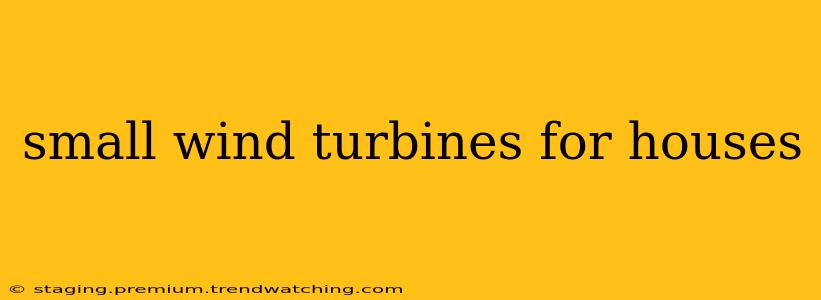Harnessing the power of the wind to supplement your home's energy needs is becoming increasingly appealing. Small wind turbines, also known as residential wind turbines, offer a compelling solution for homeowners looking to reduce their carbon footprint and potentially lower their electricity bills. However, before you rush to install one, understanding the intricacies of these systems is crucial. This comprehensive guide will explore the feasibility, benefits, drawbacks, and considerations involved in using small wind turbines for houses.
What are small wind turbines for houses?
Small wind turbines are scaled-down versions of the large wind turbines found in wind farms. Designed for residential use, these turbines are smaller in size and capacity, typically ranging from a few hundred watts to a few kilowatts. They capture kinetic energy from the wind, converting it into electricity that can either be fed directly into your home's electrical system or stored in batteries for later use. Their size allows for installation on rooftops, in backyards, or on other suitable locations on your property.
How much electricity can a small wind turbine generate?
The amount of electricity a small wind turbine generates depends on several factors, including:
- Turbine size and capacity: Larger turbines with higher wattage ratings naturally produce more power.
- Wind speed and consistency: Consistent, higher wind speeds result in greater energy production. Locations with low wind speeds may not be suitable.
- Turbine efficiency: Different turbine designs have varying levels of efficiency in converting wind energy into electricity.
It's important to have realistic expectations. A small wind turbine is unlikely to completely replace your reliance on the grid, but it can significantly offset your energy consumption, particularly during periods of high wind. A thorough wind assessment is essential to determine the potential energy output at your specific location.
What are the benefits of using small wind turbines for homes?
Installing a small wind turbine offers several advantages:
- Reduced reliance on the grid: By generating your own electricity, you reduce your dependence on the power grid, potentially lowering your electricity bills and increasing energy independence.
- Environmental friendliness: Wind energy is a clean and renewable energy source, contributing to a reduced carbon footprint.
- Potential tax incentives and rebates: Many governments offer financial incentives to encourage the adoption of renewable energy technologies, including small wind turbines. Check your local and national regulations for applicable programs.
- Increased property value: Some studies suggest that properties equipped with renewable energy systems, such as wind turbines, may command higher market values.
What are the drawbacks of using small wind turbines for homes?
Despite the benefits, there are also potential drawbacks to consider:
- High initial cost: The upfront investment for purchasing and installing a small wind turbine can be significant.
- Maintenance requirements: Like any mechanical system, wind turbines require regular maintenance to ensure optimal performance and longevity.
- Noise pollution: Some wind turbines can produce noticeable noise, especially during periods of high wind. Choose quieter models and consider their placement carefully.
- Visual impact: The turbine's visual presence may not appeal to everyone, potentially impacting property aesthetics. Consider the turbine's design and placement in relation to your home and surroundings.
- Permitting and regulations: Local regulations and permitting requirements may vary. Ensure you comply with all applicable laws and regulations before installation.
Are small wind turbines worth it for my home?
The viability of installing a small wind turbine depends heavily on your specific circumstances. Consider the following:
- Your location's wind resource: A comprehensive wind assessment is crucial to determine if your location receives sufficient and consistent wind to justify the investment.
- Your energy consumption: Assess your home's energy usage to determine how much of your energy needs a wind turbine could realistically meet.
- The cost of installation and maintenance: Factor in the initial investment, ongoing maintenance costs, and potential tax incentives or rebates.
- Local regulations and permitting requirements: Research your local zoning laws and building codes related to wind turbine installations.
What are the different types of small wind turbines?
Small wind turbines come in various designs, each with its own advantages and disadvantages:
- Horizontal-axis wind turbines (HAWTs): These are the most common type, with blades rotating around a horizontal axis. They are generally more efficient in higher wind speeds.
- Vertical-axis wind turbines (VAWTs): These turbines have blades rotating around a vertical axis. They are less sensitive to wind direction but may be less efficient than HAWTs.
How much do small wind turbines for homes cost?
The cost of small wind turbines for homes varies significantly based on the turbine's size, capacity, features, and the installation complexity. Prices can range from a few thousand dollars to tens of thousands of dollars.
How do I choose the right small wind turbine for my home?
Selecting the right small wind turbine involves careful consideration of various factors. Consult with renewable energy professionals to assess your specific needs and identify a suitable turbine that meets your energy requirements, budget, and local conditions.
This guide provides a comprehensive overview of small wind turbines for houses. Remember that conducting thorough research and seeking professional advice is crucial before making a decision. Investing in a wind turbine is a significant undertaking, and careful planning will ensure you make an informed choice that meets your individual needs and expectations.

